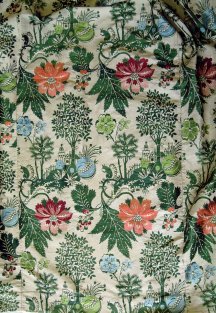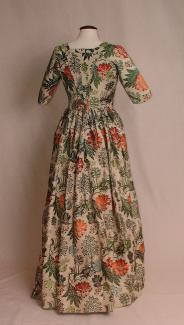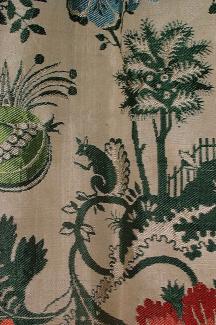The gown is made out of silk which can be dated to about 1734. The gown has been altered several times in the course of its existence. It was later remodelled to the style of the 1770s, and probably again during the 19th century for fancy dress. The dress had been bought for Hampshire's collection at a farm sale near Brockenhurst in the New Forest in 1971.
The story concerns the family which might have ordered the silk to be made into a gown and the later reuse of the gown as fancy dress, the gown's life as an heirloom and its subsequent sale to Hampshire County Council Museums and Archives Service.
The seller of the gown recalled that his grandfather had married a Miss Graham of Lamb's Hill Farm, about ten miles from Glasgow, which had been the Graham's family home since 1690. He thought it came from them.
The Grahams are thought to have been in business and may either have bought from a local Scottish merchant or through connections of their own trading in London. As a prosperous lowland Scots family they would have wanted to wear the current fashions. The owner remembered that the Earl of Eglinton invited the Grahams to the famous Eglinton Tournament held at Eglinton Castle in the west of Scotland on 27 August 1839, at which event the Earl recreated the atmosphere of the age of chivalry.
A Graham family story referred to the gown being reused by one of them as a Medieval-style costume at the Eglinton Tournament. A portrait of the Earl (right) shows him dressed in gold armour and mounted as a medieval knight at the Eglinton Tournament. There is a display about the Eglinton Tournament in the British Galleries at the V&A. However, some of the alterations to the bodice of the gown are machine made, and later in date than the Eglinton Tournament; it seems likely that the gown continued to be used at least until the 1890s.
CONSTRUCTION OF THE DRESS
An open gown was a garment with a centre front opening in the skirt that persisted as fashionable dress for a number of centuries including that of the eighteenth. It was worn with a petticoat revealed at the centre front. The gown consists of a bodice attached to a long skirt which is closed at the back. The bodice is sleeved and attached to the skirt at the back and around the sides up to where the skirt is open at the centre front. The skirt is divided into six longitudinal panels each of which is 38 cms wide. There is a central seam down the centre back of the skirt.
There are four pleats at the centre back of the bodice. The bodice of the Hampshire gown is thus a closed bodice and not an open one over stays (a stiff corset worn over the chest and stomach underneath the gown but exposed at the centre front) although it may originally have had an open bodice before being altered to a closed one in 1770-1780 in the style of those decades. Before alteration, the bodice was probably open with revers extending from the neck down the bodice opening of the gown, these are known as robings. These robings were probably on either side of the stays before the gown was altered from a sackback gown, or loose informal robe with a flowing back, held in place by pleating at the shoulders with a bodice-front shaped to the figure.
It is likely that the loose sackback gown was fitted to the back, in the later more figure-hugging style, while it was draped on the body as was usual practice in the eighteenth century. The bodice back was probably cut in one piece with the centre back skirt which was pleated directly onto the body. Underneath the gown, a hoop may have been worn. It was attached around the waist over the shift (undergarment made out of linen). The large, floral patterns of the first half of the eighteenth century could be displayed best when worn over a hoop and pocket.
There are two machine-made darts on each outer edge of the lining of the inside of the bodice. These darts were probably made in the1880s-early 1900s to fit over a corset of about the1890s for fancy dress.
THE SILK
The silk fabric, of which the gown was made, was an expensive choice because considerable effort went into its design and construction. It is a specific type of textile known as a 'tissue'.
Tissues were stocked in leading mercers' shops. Daniel Defoe described in his manual, The Complete English Tradesman, published in 1727, a shopping incident which illustrates the preference of customers for French silks and the dishonesty of mercers who, in passing English silks off as French, discourage esteem for English products. The mercer buys English silks, which he pretends are French, and then tricks his customers into buying them at great expense. The type of silks which he commissions are described thus:
'He sets these skilful Artists to work, and to rack their Invention for new out-of-the-way Fancies and Patterns of Silks, such (to be sure) as have not been seen in the Town before; the Workmanship is exquisitely good, the Silk rich and weighty, the brocades thick and high, and the patterns flaming in Fancy'
There are female shoppers who look at many of the silks but do not buy anything. The women are leaving when the mercer tells them that he has French silks, smuggled ones, so that they must not be seen except upstairs in his dining room. He sold such a silk for '32s 6d a Yard' which Defoe has considered that he could afford to sell for '18 to 20, or 22s'. Further evidence of the cost of silks at this date is provided by a letter written by Baillie John Steuart of Inverness addressed to a 'John Faikny (London)', dated '1722' in which he ordered 'deliver to Robert Rankins own hands, 26 yeards striped lute strong silk, green and whyt, and 26 yeards ditto blew and wheat, making in all 52 yeards. It is for making tuo swits of Cloaths for tuo young lasses, and the price is commonly from 3s. to 3; 6d pr. yeard'.
If a plain silk were 3s a yard in 1722 and brocaded silk tissue 22s or even 32s in 1727 then the brocaded silk tissue of this gown was indeed an expensive silk.




